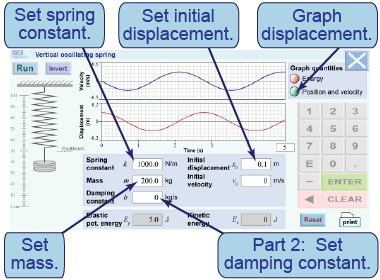| | Essential questions | | How are oscillators used? | |
|
When you extend or compress a spring, most of the work you do is converted into stored elastic potential energy in the spring. If the mass attached to the spring is allowed to move, this stored energy causes the spring and mass to oscillate. The spring in a car’s shock absorber allows the wheel to go up and down over uneven roads independently from the whole car. The resultant oscillations, however, are undesirable for passengers! In this investigation, you will use an interactive simulation to see how frictional damping is used to reduce oscillations while still allowing wheel movement. 
|
Part 1: Springs in a car’s suspension
 Consider a 1,500 kg car chassis that supports its mass evenly among four suspension springs, one for each wheel, that compress 10 cm when the car is at rest.
Consider a 1,500 kg car chassis that supports its mass evenly among four suspension springs, one for each wheel, that compress 10 cm when the car is at rest. - Draw a free-body force diagram of the chassis showing the gravitational and elastic forces that are in equilibrium.
- Use the diagram to calculate the spring constant k that is required to support one-fourth of the mass of the car when depressed by 10 cm.
- Is this a stiff or a loose spring? Do large or small values of the spring constant k correspond to a stiff or loose spring?
- Use the interactive simulation to model that spring by setting the mass, spring constant, and displacement. How much energy is stored in the spring?

|
In this interactive simulation, you will compress or expand a spring and then see how the system oscillates. You have the option to add damping from a viscous fluid, as is found in the shock absorbers of a car’s suspension. For each configuration, press [Run] to see how the system oscillates in time. Select “Energy” or “Position and velocity” to see each set of graphs of the oscillatory motion.
|
Part 2: Shock absorbers and damped oscillations
 This interactive simulation models the response of a damped car-suspension spring. You can set the initial displacement from equilibrium, x0, spring constant k, and mass m, as well as the damping constant b.
This interactive simulation models the response of a damped car-suspension spring. You can set the initial displacement from equilibrium, x0, spring constant k, and mass m, as well as the damping constant b. - Let the damping constant b = 0 and give the spring a displacement of 10 cm, simulating a wheel hitting a pothole. Describe the resulting motion of the 1,500 kg car. Is this desirable? Why or why not?
- Set b = 100 kg/s. How does this affect the period and amplitude of the motion? Graph the resulting motion for b = 100 and 25,000 kg/s.
- Adjust the damping constant b until you achieve two goals. First, the wheel should be able to move down as much as possible to accommodate potholes. Second, the subsequent oscillations should damp away quickly. What value of b is optimal?
- What happens to the damped energy lost by the spring?

| |
| |
|

